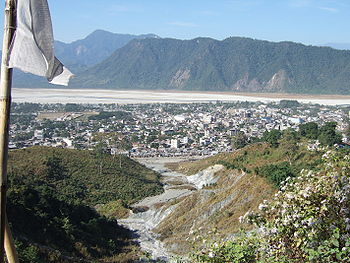Chukha District
This article needs additional citations for verification. (July 2017) |
27°0′N 89°30′E / 27.000°N 89.500°E
Chukha district
ཆུ་ཁ་རྫོང་ཁག | |
|---|---|
District | |
 Chukha Dzong | |
 Map of Chukha District in Bhutan | |
| Country | Bhutan |
| Headquarters | Chukha |
| Area | |
| • Total | 1,880 km2 (730 sq mi) |
| Population (2017) | |
| • Total | 68,966 |
| • Density | 37/km2 (95/sq mi) |
| Time zone | UTC+6 (BTT) |
| HDI (2019) | 0.684[1] medium · 4th |
| Website | www |


Chukha District (Dzongkha: ཆུ་ཁ་རྫོང་ཁག་; Wylie: Chu-kha rdzong-khag; officially spelled "Chhukha" [2]) is one of the 20 dzongkhag (districts) comprising Bhutan. The major town is Phuentsholing which is the gateway city along the sole road which connects India to western Bhutan (cf. Lateral Road). Chukha is the commercial and the financial capital of Bhutan. With Bhutan's oldest hydropower plant, Chukha hydel (completed in 1986–88), and Tala Hydroelectricity Project, the country's largest power plant, Chukha is the dzongkhag which contributes the most to the GDP of the country. Also located in Chukha district are some of the country's oldest industrial companies like the Bhutan Carbide Chemical Limited (BCCL) and the Bhutan Boards Products Limited (BBPL).
Languages
[edit]In Chukha, the main native languages are Dzongkha, the national language, and Nepali, spoken by the Lhotshampa in the south. The Bhutanese Lhokpu language, spoken by the Lhop minority, is also present in the southwest along the border with Samtse District.
Administrative divisions
[edit]Chukha District is divided into eleven village blocks (or gewogs):[3]
Environment
[edit]Chukha Dzongkhag covers 1,880 sq. km,[4] but unlike most other districts, Chukha, along with Samtse, contain no protected areas of Bhutan. Although much of southern Bhutan contained protected areas in the 1960s, park-level environmental protection became untenable.[5][6]
See also
[edit]References
[edit]- ^ "Sub-national HDI - Area Database - Global Data Lab". hdi.globaldatalab.org. Retrieved 2018-09-13.
- ^ official website of Chhukha Dzongkhag Administration http://www.chhukha.gov.bt/
- ^ "Chiwogs in Chukha" (PDF). Election Commission, Government of Bhutan. 2011. Archived from the original (PDF) on 2011-10-02. Retrieved 2011-07-28.
- ^ Wanggchuk, Lily (2017). Facts About Bhutan The land of the Thunder Dragon. Bhutan: Absolute Bhutan Books. p. 290. ISBN 978-99936-760-0-3.
- ^ "Parks of Bhutan". Bhutan Trust Fund for Environmental Conservation online. Bhutan Trust Fund. Archived from the original on 2011-07-02. Retrieved 2011-03-26.
- ^ "The Organisation". Bhutan Trust Fund for Environmental Conservation online. Bhutan Trust Fund. Archived from the original on 2010-03-29. Retrieved 2011-03-26.
External links
[edit]- Official Dzhongkha profile[permanent dead link] with a map of gewogs
- Five year plan (2002–2007)
- Travel diary from Phuentsholing
- Urban problems in Phuentsholing From RAO Online
